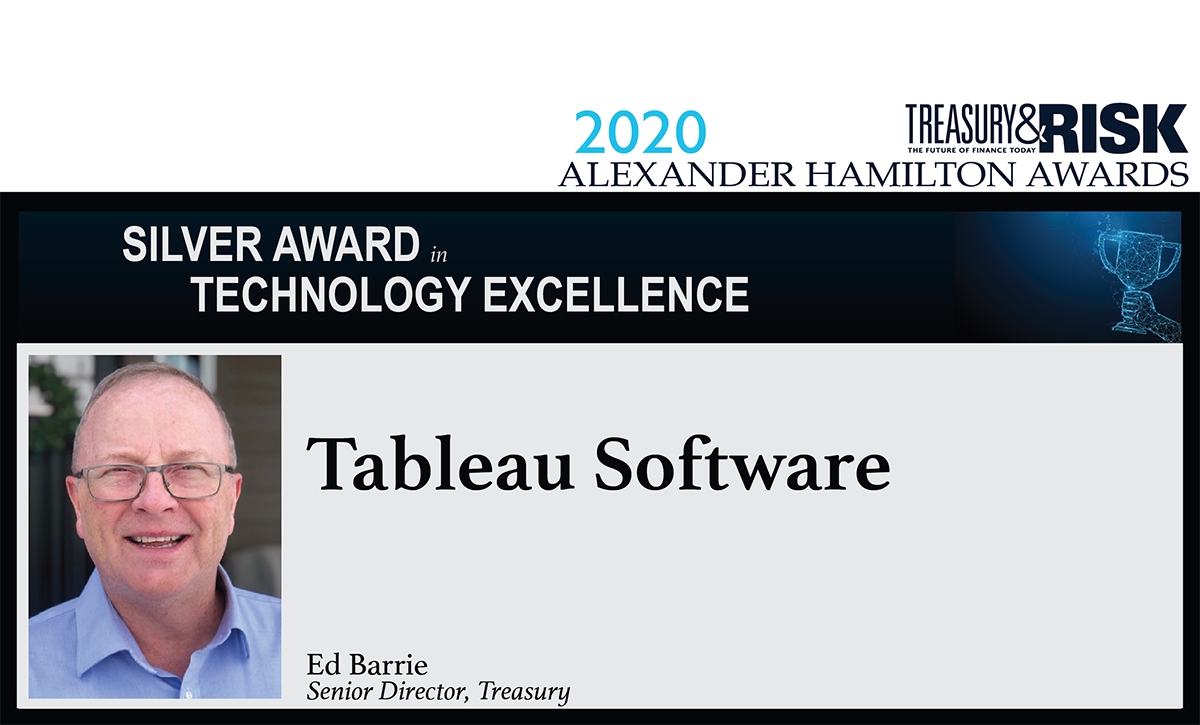
Tableau Software, which has been a wholly owned subsidiary of Salesforce since August 2019, knows how to make data easy to comprehend. Tens of thousands of businesses around the world use Tableau dashboards to make sense of their financial data. Still, several years ago, the Tableau treasury team struggled to see their own global cash balances and transactions.
"Every day, the controllership would log into various online banking portals and generate statements for the previous day's activity," says Ed Barrie, senior director of treasury. "They would use these statements for manual accounting and reconciliation processes, while the cash application team was manually posting and clearing cash receipts against open customer invoices. We had dozens of bank accounts across several different banks, so this approach was quite inefficient. In addition, the fact that they were always utilizing the previous day's statement meant liquidity and accounting activities were operating on a one-day lag."
Recommended For You
The opacity of corporate treasury data led to significant business challenges. "Daily global visibility into all bank and investment account balances and transactions is a fundamental requirement for any corporation," Barrie says. "Anything less results in a suboptimal understanding of where your cash is and where it needs to be. That is a problem not only for cash positioning, but also for forecasting."
When he joined Tableau in 2015, one of his first priorities was to begin consolidating and standardizing treasury-related data. First, Barrie established SWIFT connectivity. "I had previously been involved in two other corporate SWIFT implementations, so I knew we could stand that up pretty quickly and efficiently with our banking partners," Barrie says.
Tableau didn't have a treasury management system and didn't intend to implement one. The treasury group had a vision of a comprehensive respository of treasury data. They wanted better integration with their enterprise resource planning (ERP) and other systems than commercially available treasury management systems were offering at the time. They also wanted to take full advantage of their impending SWIFT Alliance Lite2 connectivity, through which bank statement data would flow into the organization in CAMT.053 or BAI2 formatting.
"We were going to be getting ISO 20022 XML bank statements," Barrie explains. "We saw the potential to capture this enriched data at the transaction level. We also wanted to use the ERP system to generate ISO XML payment files that would include our payment message, transaction details, and remittance data. Providing the bank with the data we wanted to get back would make our bank statements more effective. The treasury management systems we looked at weren't fully supporting the ISO XML format in these ways."
Instead of deploying a commercial solution, the treasury group decided to build one internally. They worked with the company's finance analytics team to set up a cloud-based data repository they called the "financial master data warehouse." The Alliance Lite2 connection began automatically populating 'financial master' with bank statement information on a daily basis. Tableau's finance analytics team also set up a mechanism for importing data from their customer relationship management (CRM) and enterprise resource planning (ERP) systems. Then they installed Tableau software on the front end to make the 'financial master' data easily accessible to authorized end users.
"Our use of Tableau enabled treasury and finance staff to build whatever analytics they needed," Barrie says. The new system, which revolved around the 'financial master' repository of consolidated treasury data, enabled users to look for trends in all kinds of financial transactions, from purchase orders to vendor invoices to expense reimbursement.
 The next step in the system's evolution was to enrich the data to make it even more useful. "Most treasury management systems have categorization or tagging rules," Barrie says. "A transaction is labeled with its bank account, with a transaction code, and with narrative text. We did something similar in 'financial master.' In place of transaction codes, we created a taxonomy of cash flow types and sub-types to enhance our reporting and analysis."
The next step in the system's evolution was to enrich the data to make it even more useful. "Most treasury management systems have categorization or tagging rules," Barrie says. "A transaction is labeled with its bank account, with a transaction code, and with narrative text. We did something similar in 'financial master.' In place of transaction codes, we created a taxonomy of cash flow types and sub-types to enhance our reporting and analysis."
A transaction might be labeled accounts payable (A/P) or accounts receivable (A/R), foreign exchange (FX), tax, payroll, intercompany payment, or a number of other options. "We have around 15 types and then a myriad of sub-types," Barrie explains. "So, for example, a tax transaction might be assigned a cash flow sub-type for payment to a specific U.S. state, or it might be a VAT [value-added tax] if it's international, or it might be categorized as a tax refund."
Barrie's team developed rules by which the data warehouse could automatically assign transactions to specific cash flow types and sub-types. One benefit of the detailed categorization was that it helped the accounting team ensure transactions were posted to the right general ledger (G/L) account.
"Things like bank fees, credit interest, debit interest, ZBA [zero-balance account] transfers between accounts—types of transactions which don't exist natively in an A/P or A/R subledger system—were labeled in our data warehouse," Barrie says. "Categorizing transactions down to that level gave us great visibility to understand our cash flows and what happened in a given month. From there, we could compare actuals to forecast and use the insights from that analysis as we prepared the next forecast."
The system provided other, less obvious benefits as well. "This project also brought everybody together to a common understanding of our data set," Barrie adds. "So our cash application team that was recording A/R payments would see the same data as the forecasters and the controllership team and the auditors."
Because they developed the data warehouse internally, the team was able to build additional functionality to support deep data analysis. Its cash flow analysis dashboard made both bank account balances and historical cash flows much quicker and easier to access. A cash application dashboard dramatically improved the efficiency of applying customer payments to open invoices. The accounting team was able to close the books more efficiently at each period-end: Bank accounts were assigned to a distinct G/L account in the balance sheet which allowed for comparison of G/L activity and balances with bank statements. Other types of data comparisons were also automated, generating alerts anytime transactions were not categorized and in cases where transaction data on the bank statements did not tie out to closing ledger balances.
"Extending the concept of the categorization rules, our dashboards provided different levels of insights," Barrie says. "For example, we could look at everything at an individual bank account level, or we could roll up multiple accounts to a subsidiary or legal entity view. We could roll up everything to a total view by currency. We could see amounts in U.S. dollar equivalency using the applicable FX rates from Tableau's ERP system."
The Salesforce acquisition of Tableau "changed our roadmap in terms of treasury technology," Barrie says. "Still, our experience with this project helped foster a continuous improvement mentality throughout our treasury team. We were constantly looking at ways to improve treasury processes, constantly building out new features and functionality in the 'financial master' system.
"In treasury, as elsewhere in life, you have to own your destiny—you have to own your outcome," Barrie continues. "To fully leverage the technology you have at hand, you need to periodically refresh your roadmap and adjust your capabilities. Look at what's changing in the industry and in your business. Consider what questions you would really like to answer and what data you would need to do that."
In fact, Barrie draws a parallel between this continuous improvement attitude toward technology and the future of treasury careers. "Best-in-class treasury teams are becoming almost a center of excellence for analytics," he concludes. "Treasury sits at the nexus of everything that's going on in an organization, so treasury teams have a view of everything that's touching corporate cash. They have access to streams of data from across the organization that they need to tap in order to understand cash flows. Treasury professionals who aren't continuously improving their financial analytics skills and leveraging data are at risk of being left behind."
Join Treasury & Risk for a webcast celebrating the winners of our 2021 Alexander Hamilton Awards in Technology Excellence! The live virtual event will take place on March 17 at 2pmET. Register today.
See also:
- ONEOK Drill for Liquidity Gold as an Early Adopter of APIs
- Small but Mighty: Technology Supports Treasury Staff Optimization
© Touchpoint Markets, All Rights Reserved. Request academic re-use from www.copyright.com. All other uses, submit a request to [email protected]. For more inforrmation visit Asset & Logo Licensing.



